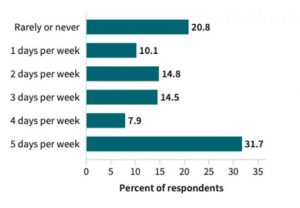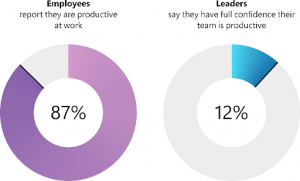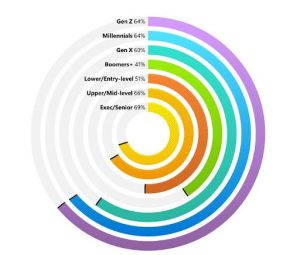
Benefits of hybrid working for employers
Since the start of the pandemic, there has been a lot of debate around the effectiveness of work-from-home and hybrid-working models. There is no doubt that the benefits for employees are far reaching, from reduced commuting time, to being able to spend more time with family, hobbies and have improved mental health. But does this added freedom come at a cost to the employer?
In this article we delve deeper into hybrid working models and examine the benefits of hybrid working models to employers.
The history of hybrid working models
Since the early 2000s when the internet became common use, hybrid working models have been adopted in various industries – from IT support to investment and beyond. The COV-19 pandemic accelerated this transition undoubtably, but whether the workplace was prepared for this shift is a different story, and one we should pay attention to. The sudden change in work practices to remote or hybrid work was reasonably well accepted across most industries, but what was the impact on employers?
What are the challenges of hybrid work?
Since hybrid-work and remote-work is here to stay, we need to find a middle-ground and determine when the model is possible or not, and to which extent. In a Stanford University study of over 35 000 people in the US workforce, some interesting findings came to light. Of those respondents, 32% said they never want to work in an office again, and 21% said they never want to work from home again. This is an indication of the subtler conflicts that revolve around employees in different sectors and industries, and the implementation of hybrid, remote or in-office work.
In 2015, 250 volunteers in a Chinese firm were randomly placed in a work-from-home group or an in-office work group. After a 21-month period, the work from home group had a 50% lower rate of promotion than the group that worked in office. Proving a significant disadvantage for work-from-home employees concerning career growth. In Addition to this, Stanford University found that the amount of days that employees want to work from home or in the office vary a lot.

This begs the question, how should organisations respond?
A Microsoft study published in September 2022 revealed some key pivots that leaders and organisations will need to make to accommodate hybrid work models.
- Manage productivity paranoia
- Understand that employees return to office for social connections
- Become a learning-oriented organisation

Managing productivity paranoia
There is a big disconnect between leaders and employees’ opinions about employee productivity in work-from-home models. While 87% of employees feel they are more productive, only 12% of leaders have full confidence that their teams are productive.
To overcome this obstacle:
- Set goals and objectives to ensure that the work done by an employee aligns and supports the organisational goals and objectives. In tandem to this, identify what employees should not do to get the most important work done.
- Cultivate an organisational culture that rewards an impact of an employee’s work, rather than their activity. This avoids employees faking their work activity and promotes a more engaged workforce.
- Gather feedback from employees at all levels in the organisation and empower managers and leaders in the organisation to actively listen, mentor and engage in critical thinking and decision making. This will improve the performance of all teams and groups across the organisation.
Employees want social interaction
In the Microsoft study “84% of employees would be motivated by the promise of socialising with co-workers, while 85% would be motivated by rebuilding team bonds”. Additionally, 73% reported that they would go to the office more frequently if they knew their team members were there.
This shows that employees often have a need for social interaction, but working in-office is not the only solution to this disconnect. Supporting technology to connect employees plays a critical role in meeting these employee needs, especially in hybrid-working models.
To establish a powerful and healthy workforce, you can approach it with the following steps:
- Build team and individual bonds with in-person time.
- Develop a digital employee experience that supports employees to stay connected to leadership and the organisational culture, regardless of where they are based.
- Build a community online throughout your organisation that will support conversation and expression. This will help leadership and employees connect and build a stronger organisational culture.
Become a learning-oriented organisation
When we consider employee needs, learning is a significant priority for the vast majority of employees. This, coupled with the need to grow careerwise, puts significant pressure on organisations to empower their employees through learning.
While the assumption is that employees can learn from their own organisation and gain promotions, employees are of the opposite opinion. The majority across the board feel that in order to learn, they need to leave their organisation and work at a different company. This is a worrying trend for businesses that want to hold onto their skilled employees. To retain employees and maximise their growth, you need to accommodate learning in both career as well as personal development.

- Incorporate learning into the employee experience with resources and learning experiences.
- Support personal and professional development. The organisation should make internal mobility a priority by allowing employees flexibility at moving through the organisation internally.
- View your organisation as an “internal market place”, where employees are able to grow their skills, build careers and contribute to the growth of the organisation.
What are the benefits of hybrid work models to employers?
Now that you have some guidance on how to approach and accommodate hybrid-working models, let’s review some of the key benefits.
Employee wellness has been on the forefront of many human resource discussions lately. While working from home has many benefits for the employee, the advantages for the employer may not be as obvious – but they are nevertheless equally if not arguably more important to the sustainability of a business.
Reduces operating costs
Businesses with offices have significant operational costs to consider. By implementing a hybrid-work model, the reduction of in-office employees means that less office resources are used, and in turn, less expenditure for the business. The operational costs are reduced in three core areas:
Property: While less employees are working in-office, businesses are able to rent smaller offices, thereby reducing the monthly rental costs. Additionally, less employees will be in the office and consequently there is a reduction in water and electricity usage, lower telephone bills and less furniture that will need to be purchased for the office.
Food: Many employers supply food and refreshments to their staff members – another cost to be reduced.
Maintenance: Since the office facilities will be used less frequently, it reduces the amount of maintenance that needs to be done to keep the office running. This includes lights, amenities, IT, internet usage just to name a few.
Increased employee productivity
While the office is a great place to build camaraderie between employees, brainstorm and build a work culture, the distractions at the office are undeniable. From colleagues requiring assistance, to informal discussions at the water fountain, as much as they are great for building team spirit, they are also significant distractions. By reducing distractions and enabling employees to work from home, a business cultivates a more productive workforce.
Reduces commuting time
For many employees, commuting to the office is a time consuming endeavour. Whether they are using the train, bus, taxi, bicycle or walking, the time it takes to commute to work often takes well over 3 hours out of an employee’s day – not considering the energy it takes.
Employees are able to spend the time commuting in ways that are beneficial to themselves, as well as to the employer. Reduced commuting time gives employees more time in a day to work and spend less time and energy commuting. In turn, the business gains more productivity due to employees being better rested, having improved mental health and being less stressed.
In addition to health and time management for employees, companies like Deloitte are using the reduced commuting time to mitigate the carbon footprint of the organisation. With less vehicles and office space being used, corporations are able to reduce their impact on carbon emissions too.
Access to a bigger talent pool
Work-from-home and hybrid-working models enable employers to look for employees beyond their geographical proximity. An employer on the East Coast can easily hire an employee from the West Coast, and consequently employers have more options to choose the right candidate for a role. This pool of possible employees grows exponentially as you include a bigger variety of jurisdictions and countries in your talent pool.
Improved employee wellness
The majority of employees feel that hybrid-work models are essential to their mental wellbeing. The reasons vary, but the most common ones are due to a reduced commuting time and being able to spend more time on personal aspects – such as exercise, spending more time with family and friends and being less pressed for time while working. In return, businesses gain a healthier workforce, driving up productivity, innovation and furthering the businesses goals and objectives.
Conclusion
Hybrid working models aren’t a new innovation, but rather a sped up adoption due to the COV-19 pandemic. Not all businesses were (or are) prepared for the transition, and many have doubts about the efficiency of the models. Based on the studies done it is clear that there are ample benefits to employees and employers alike, with many of the advantages benefiting both parties.
Learn more about developing a hybrid workforce with our course.